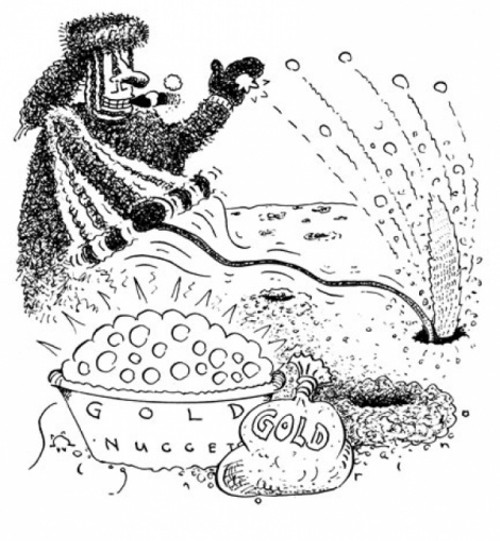Agreed, this sounds dubious. “Gopher the gold”? Please. However, merely getting to the bottom of a historical fine point wasn’t a mission to set our pulses pounding. We thought of a potentially more profitable research topic: Could gold extraction via gopher, or some approximation thereof, actually work?
Answer: yes. Before we get into that, however, we’ve got to kill a 113-year-old joke.
• Although there are lots of recent references to gopher mining ventures in the Klondike, the only one I could find dating from the time of the gold rush (which was actually focused on the Canadian Yukon, not Alaska) turns up in an 1897 book, Alaska and the Klondike Gold Fields by A.C. Harris. The book appeared at the height of Klondike fever—although the first Klondike gold was found in 1896, the rush didn’t really start till the following year. Not that I’d ever doubt a fellow scribe, but knowing that this 528-page volume was thrown together in a few months doesn’t make you think fact-checking was a real priority.
• Harris’s discussion of gophers consists in its entirety of the following: “Inventors, speculators, promoters, and prospectors are going about like modern genii with propositions for making everybody immensely rich. … Shares in the Consolidated Trans-Alaskan Gopher Company, offered at one dollar each, will return dividends of ten dollars a minute as soon as the company gets to work. The idea is to take contracts for tunneling claims with trained gophers. Nothing is impossible, nothing chimerical.”
• Come now. Consolidated Trans-Alaskan Gopher Company? We’re supposed to believe this enterprise was formed from the merger of two or more previous gopher start-ups? Add in the bit about dividends of $10 a minute and it’s reasonably clear we’re dealing with a 19th-century wise guy. Was it Harris’s own gag or something he heard about? Dunno. But no way was this a (so to speak) legit scam.
Here the anal will protest: Isn’t it your duty to head up to Skagway, jumping-off point for many would-be Klondike prospectors, to see if you can scare up a C.T.-A.G.C. stock certificate? Sorry—that didn’t seem like an advantageous use of the beer money. A better idea, we thought, was to look into bioprospecting—the use of plants and animals to find minerals, ideally gold.
Plants are the easier part of this to understand. They take up minerals from the soil, so subjecting them to lab analysis can sometimes tell you whether there’s anything down there worth strip-mining. One Australian shrub is so good at sucking up minerals that if you incinerate its leaves, almost a quarter of the resultant ash is nickel, making it potentially hazardous waste.
Another way to find minerals is looking for so-called indicator plants. For example, early English miners kept an eye out for discolored vegetation or stunted crops, signs of lead deposits near the surface. Plants such as onion, sego-lily, and desert trumpet have been used to find uranium. More pertinently for our purposes, a certain type of wild buckwheat tends to grow over Montana silver deposits.
Alas, though at least 80 different plants have been claimed to be mineral indicators, none has been found to point specifically to gold. True, some indicate arsenic, which is commonly present in gold ore. But we can do better than that. Let’s turn to our friends the animals.
• In the fifth century BC, the Greek historian Herodotus wrote of giant ants “bigger than foxes” in India who dug up mounds of gold-bearing soil while burrowing. The locals would later extract the gold from the dirt. French ethnologist Michel Peissel says this much-mocked tale is actually true—it’s just that “ant” was a mistranslation of the Persian name for the marmot, a type of largish rodent. Peissel claimed in 1996 to have found a high plateau near the India-Pakistan border where marmots burrow into gold-bearing sand, leaving piles that villagers then sift for gold dust.
• Meanwhile, termites in arid lands must dig deep tunnels to get to underground water sources. When they encounter soft ore, they bore right through it and bring the gold-bearing tailings to the surface. Termite mounds have thus been used to detect gold deposits in Africa. In Mali, gold is collected directly from the mounds; in Zimbabwe an operation named Termite Mine was opened on a site that the insects had suggested.
Now we’re getting somewhere. Never mind gophers—a more promising business would be the Consolidated Trans-Alaskan Marmot and Termite Company. Could these critters actually be used to find gold in places other than African deserts or Himalayan plateaus? Hell if I know, but I think we’ve got the makings of a first-class scam.
Send questions to Cecil via straightdope.com or write him c/o Chicago Reader, 11 E. Illinois, Chicago 60611. Subscribe to the Straight Dope podcast at the iTunes Store.
More by Cecil Adams
-
This Is the End, My Friend
This week's Straight Dope marks the last appearance of the column as the Teeming Millions have known it for the past 45 years.
- Jul 11, 2018
-
Do Brain Supplements Do Anything?
Brain Drain
- Jul 4, 2018
-
Is flying really worse for the environment than driving?
Planes and Trains
- Jun 27, 2018
- More »




